Evolving Culinary Trends and Their Impact on Dietary Practices
VerifiedAdded on 2020/04/21
|11
|3891
|77
AI Summary
The study investigates evolving culinary trends impacting global dietary habits, highlighting the role of technological advancements, globalization, and a shift towards sustainable practices in shaping modern cuisines. Key areas include the integration of exotic ingredients into traditional diets, the rise of plant-based alternatives, and the growing consumer demand for organic and locally sourced foods. The assignment will analyze these developments' effects on health outcomes, cultural food identities, and economic dynamics within the culinary sector. By examining case studies from various regions, it aims to provide insights into how culinary practices are adapting in response to environmental challenges and changing consumer preferences.
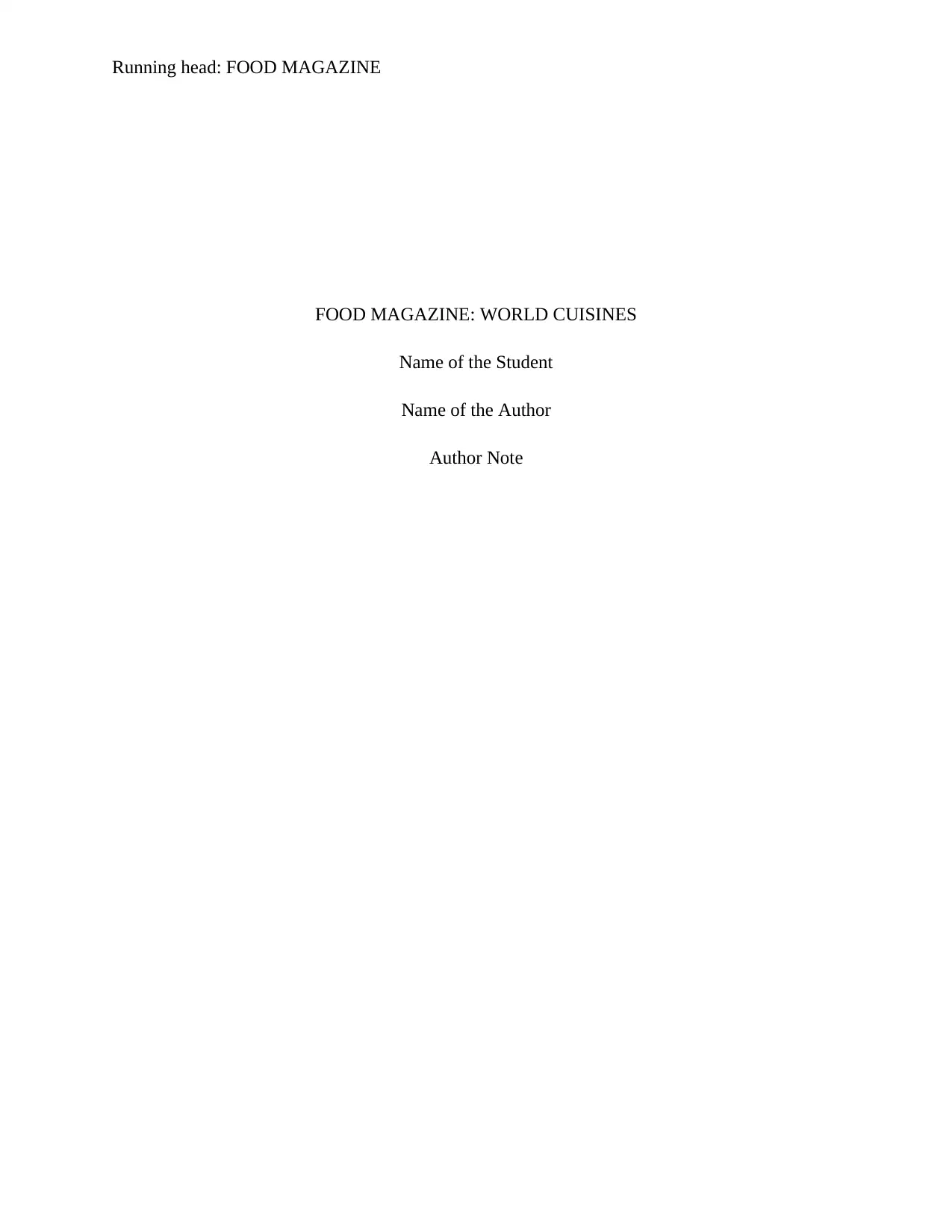
Running head: FOOD MAGAZINE
FOOD MAGAZINE: WORLD CUISINES
Name of the Student
Name of the Author
Author Note
FOOD MAGAZINE: WORLD CUISINES
Name of the Student
Name of the Author
Author Note
Paraphrase This Document
Need a fresh take? Get an instant paraphrase of this document with our AI Paraphraser
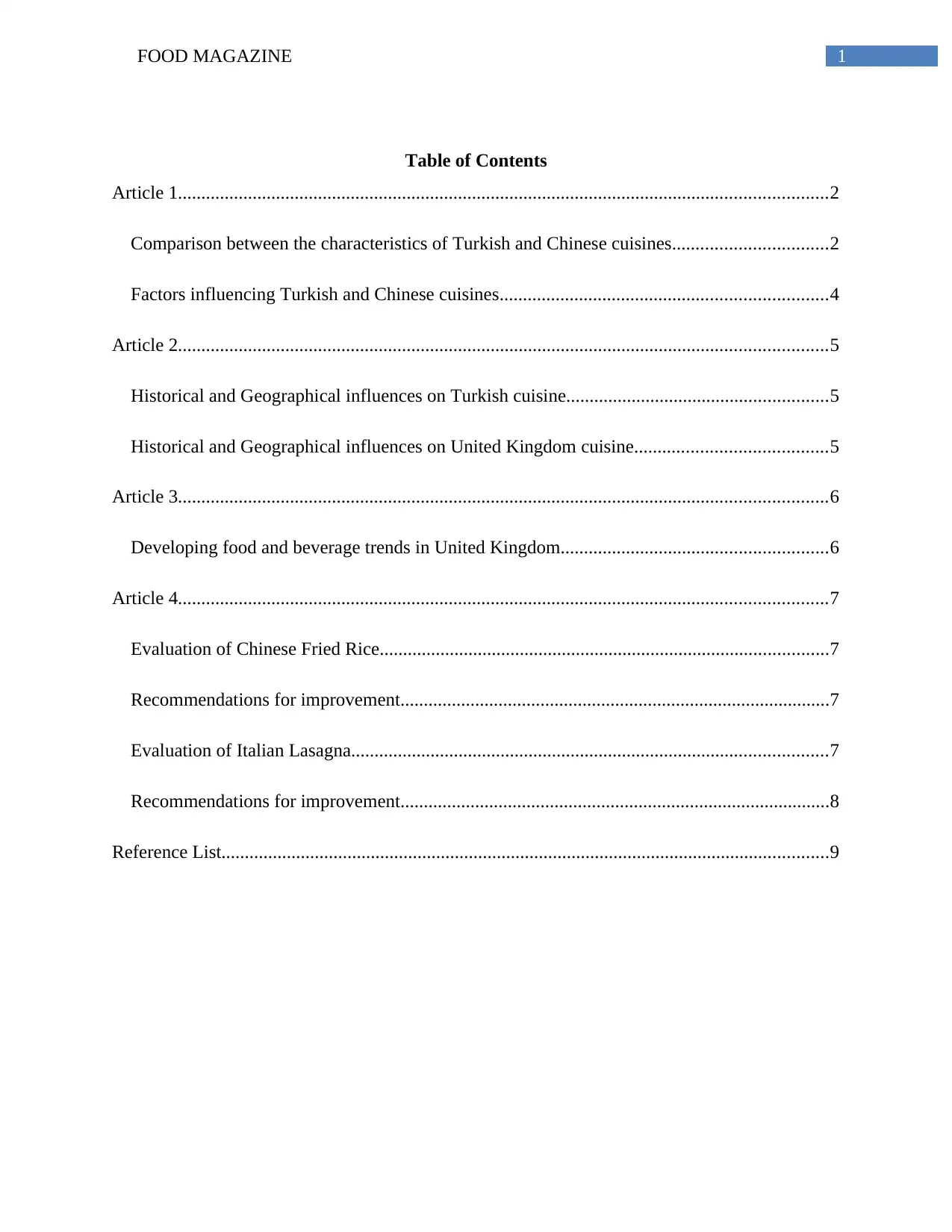
1FOOD MAGAZINE
Table of Contents
Article 1...........................................................................................................................................2
Comparison between the characteristics of Turkish and Chinese cuisines.................................2
Factors influencing Turkish and Chinese cuisines......................................................................4
Article 2...........................................................................................................................................5
Historical and Geographical influences on Turkish cuisine........................................................5
Historical and Geographical influences on United Kingdom cuisine.........................................5
Article 3...........................................................................................................................................6
Developing food and beverage trends in United Kingdom.........................................................6
Article 4...........................................................................................................................................7
Evaluation of Chinese Fried Rice................................................................................................7
Recommendations for improvement............................................................................................7
Evaluation of Italian Lasagna......................................................................................................7
Recommendations for improvement............................................................................................8
Reference List..................................................................................................................................9
Table of Contents
Article 1...........................................................................................................................................2
Comparison between the characteristics of Turkish and Chinese cuisines.................................2
Factors influencing Turkish and Chinese cuisines......................................................................4
Article 2...........................................................................................................................................5
Historical and Geographical influences on Turkish cuisine........................................................5
Historical and Geographical influences on United Kingdom cuisine.........................................5
Article 3...........................................................................................................................................6
Developing food and beverage trends in United Kingdom.........................................................6
Article 4...........................................................................................................................................7
Evaluation of Chinese Fried Rice................................................................................................7
Recommendations for improvement............................................................................................7
Evaluation of Italian Lasagna......................................................................................................7
Recommendations for improvement............................................................................................8
Reference List..................................................................................................................................9
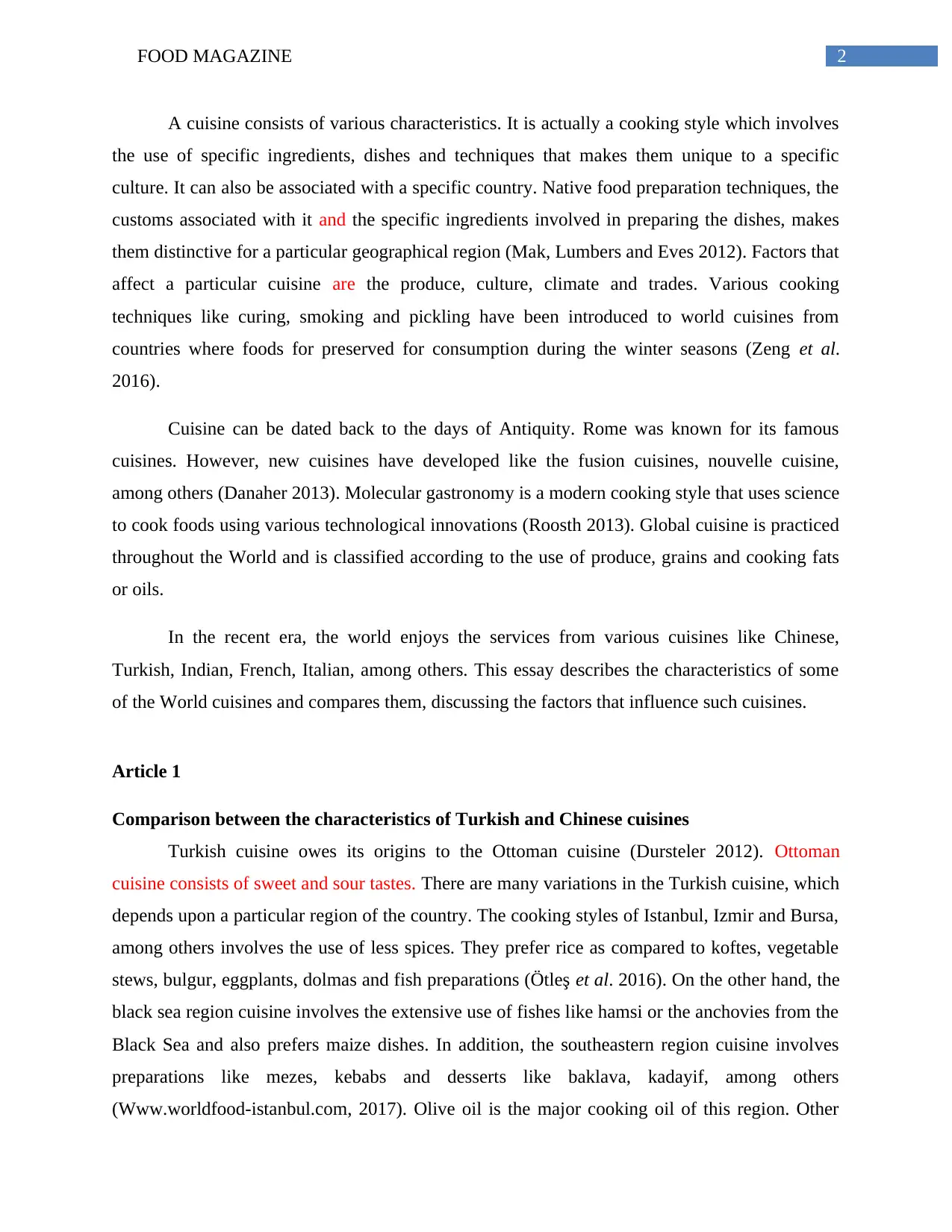
2FOOD MAGAZINE
A cuisine consists of various characteristics. It is actually a cooking style which involves
the use of specific ingredients, dishes and techniques that makes them unique to a specific
culture. It can also be associated with a specific country. Native food preparation techniques, the
customs associated with it and the specific ingredients involved in preparing the dishes, makes
them distinctive for a particular geographical region (Mak, Lumbers and Eves 2012). Factors that
affect a particular cuisine are the produce, culture, climate and trades. Various cooking
techniques like curing, smoking and pickling have been introduced to world cuisines from
countries where foods for preserved for consumption during the winter seasons (Zeng et al.
2016).
Cuisine can be dated back to the days of Antiquity. Rome was known for its famous
cuisines. However, new cuisines have developed like the fusion cuisines, nouvelle cuisine,
among others (Danaher 2013). Molecular gastronomy is a modern cooking style that uses science
to cook foods using various technological innovations (Roosth 2013). Global cuisine is practiced
throughout the World and is classified according to the use of produce, grains and cooking fats
or oils.
In the recent era, the world enjoys the services from various cuisines like Chinese,
Turkish, Indian, French, Italian, among others. This essay describes the characteristics of some
of the World cuisines and compares them, discussing the factors that influence such cuisines.
Article 1
Comparison between the characteristics of Turkish and Chinese cuisines
Turkish cuisine owes its origins to the Ottoman cuisine (Dursteler 2012). Ottoman
cuisine consists of sweet and sour tastes. There are many variations in the Turkish cuisine, which
depends upon a particular region of the country. The cooking styles of Istanbul, Izmir and Bursa,
among others involves the use of less spices. They prefer rice as compared to koftes, vegetable
stews, bulgur, eggplants, dolmas and fish preparations (Ötleş et al. 2016). On the other hand, the
black sea region cuisine involves the extensive use of fishes like hamsi or the anchovies from the
Black Sea and also prefers maize dishes. In addition, the southeastern region cuisine involves
preparations like mezes, kebabs and desserts like baklava, kadayif, among others
(Www.worldfood-istanbul.com, 2017). Olive oil is the major cooking oil of this region. Other
A cuisine consists of various characteristics. It is actually a cooking style which involves
the use of specific ingredients, dishes and techniques that makes them unique to a specific
culture. It can also be associated with a specific country. Native food preparation techniques, the
customs associated with it and the specific ingredients involved in preparing the dishes, makes
them distinctive for a particular geographical region (Mak, Lumbers and Eves 2012). Factors that
affect a particular cuisine are the produce, culture, climate and trades. Various cooking
techniques like curing, smoking and pickling have been introduced to world cuisines from
countries where foods for preserved for consumption during the winter seasons (Zeng et al.
2016).
Cuisine can be dated back to the days of Antiquity. Rome was known for its famous
cuisines. However, new cuisines have developed like the fusion cuisines, nouvelle cuisine,
among others (Danaher 2013). Molecular gastronomy is a modern cooking style that uses science
to cook foods using various technological innovations (Roosth 2013). Global cuisine is practiced
throughout the World and is classified according to the use of produce, grains and cooking fats
or oils.
In the recent era, the world enjoys the services from various cuisines like Chinese,
Turkish, Indian, French, Italian, among others. This essay describes the characteristics of some
of the World cuisines and compares them, discussing the factors that influence such cuisines.
Article 1
Comparison between the characteristics of Turkish and Chinese cuisines
Turkish cuisine owes its origins to the Ottoman cuisine (Dursteler 2012). Ottoman
cuisine consists of sweet and sour tastes. There are many variations in the Turkish cuisine, which
depends upon a particular region of the country. The cooking styles of Istanbul, Izmir and Bursa,
among others involves the use of less spices. They prefer rice as compared to koftes, vegetable
stews, bulgur, eggplants, dolmas and fish preparations (Ötleş et al. 2016). On the other hand, the
black sea region cuisine involves the extensive use of fishes like hamsi or the anchovies from the
Black Sea and also prefers maize dishes. In addition, the southeastern region cuisine involves
preparations like mezes, kebabs and desserts like baklava, kadayif, among others
(Www.worldfood-istanbul.com, 2017). Olive oil is the major cooking oil of this region. Other
⊘ This is a preview!⊘
Do you want full access?
Subscribe today to unlock all pages.

Trusted by 1+ million students worldwide
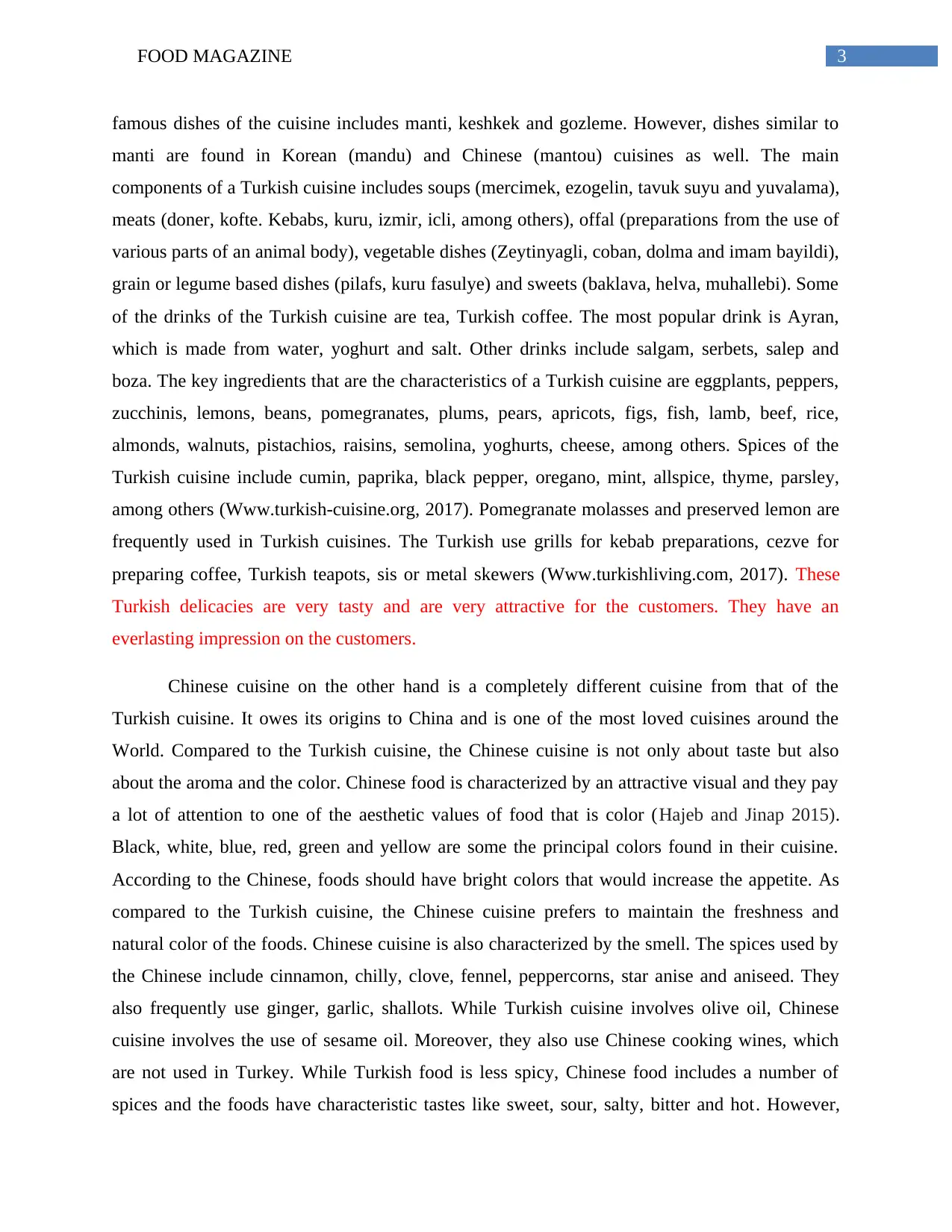
3FOOD MAGAZINE
famous dishes of the cuisine includes manti, keshkek and gozleme. However, dishes similar to
manti are found in Korean (mandu) and Chinese (mantou) cuisines as well. The main
components of a Turkish cuisine includes soups (mercimek, ezogelin, tavuk suyu and yuvalama),
meats (doner, kofte. Kebabs, kuru, izmir, icli, among others), offal (preparations from the use of
various parts of an animal body), vegetable dishes (Zeytinyagli, coban, dolma and imam bayildi),
grain or legume based dishes (pilafs, kuru fasulye) and sweets (baklava, helva, muhallebi). Some
of the drinks of the Turkish cuisine are tea, Turkish coffee. The most popular drink is Ayran,
which is made from water, yoghurt and salt. Other drinks include salgam, serbets, salep and
boza. The key ingredients that are the characteristics of a Turkish cuisine are eggplants, peppers,
zucchinis, lemons, beans, pomegranates, plums, pears, apricots, figs, fish, lamb, beef, rice,
almonds, walnuts, pistachios, raisins, semolina, yoghurts, cheese, among others. Spices of the
Turkish cuisine include cumin, paprika, black pepper, oregano, mint, allspice, thyme, parsley,
among others (Www.turkish-cuisine.org, 2017). Pomegranate molasses and preserved lemon are
frequently used in Turkish cuisines. The Turkish use grills for kebab preparations, cezve for
preparing coffee, Turkish teapots, sis or metal skewers (Www.turkishliving.com, 2017). These
Turkish delicacies are very tasty and are very attractive for the customers. They have an
everlasting impression on the customers.
Chinese cuisine on the other hand is a completely different cuisine from that of the
Turkish cuisine. It owes its origins to China and is one of the most loved cuisines around the
World. Compared to the Turkish cuisine, the Chinese cuisine is not only about taste but also
about the aroma and the color. Chinese food is characterized by an attractive visual and they pay
a lot of attention to one of the aesthetic values of food that is color (Hajeb and Jinap 2015).
Black, white, blue, red, green and yellow are some the principal colors found in their cuisine.
According to the Chinese, foods should have bright colors that would increase the appetite. As
compared to the Turkish cuisine, the Chinese cuisine prefers to maintain the freshness and
natural color of the foods. Chinese cuisine is also characterized by the smell. The spices used by
the Chinese include cinnamon, chilly, clove, fennel, peppercorns, star anise and aniseed. They
also frequently use ginger, garlic, shallots. While Turkish cuisine involves olive oil, Chinese
cuisine involves the use of sesame oil. Moreover, they also use Chinese cooking wines, which
are not used in Turkey. While Turkish food is less spicy, Chinese food includes a number of
spices and the foods have characteristic tastes like sweet, sour, salty, bitter and hot. However,
famous dishes of the cuisine includes manti, keshkek and gozleme. However, dishes similar to
manti are found in Korean (mandu) and Chinese (mantou) cuisines as well. The main
components of a Turkish cuisine includes soups (mercimek, ezogelin, tavuk suyu and yuvalama),
meats (doner, kofte. Kebabs, kuru, izmir, icli, among others), offal (preparations from the use of
various parts of an animal body), vegetable dishes (Zeytinyagli, coban, dolma and imam bayildi),
grain or legume based dishes (pilafs, kuru fasulye) and sweets (baklava, helva, muhallebi). Some
of the drinks of the Turkish cuisine are tea, Turkish coffee. The most popular drink is Ayran,
which is made from water, yoghurt and salt. Other drinks include salgam, serbets, salep and
boza. The key ingredients that are the characteristics of a Turkish cuisine are eggplants, peppers,
zucchinis, lemons, beans, pomegranates, plums, pears, apricots, figs, fish, lamb, beef, rice,
almonds, walnuts, pistachios, raisins, semolina, yoghurts, cheese, among others. Spices of the
Turkish cuisine include cumin, paprika, black pepper, oregano, mint, allspice, thyme, parsley,
among others (Www.turkish-cuisine.org, 2017). Pomegranate molasses and preserved lemon are
frequently used in Turkish cuisines. The Turkish use grills for kebab preparations, cezve for
preparing coffee, Turkish teapots, sis or metal skewers (Www.turkishliving.com, 2017). These
Turkish delicacies are very tasty and are very attractive for the customers. They have an
everlasting impression on the customers.
Chinese cuisine on the other hand is a completely different cuisine from that of the
Turkish cuisine. It owes its origins to China and is one of the most loved cuisines around the
World. Compared to the Turkish cuisine, the Chinese cuisine is not only about taste but also
about the aroma and the color. Chinese food is characterized by an attractive visual and they pay
a lot of attention to one of the aesthetic values of food that is color (Hajeb and Jinap 2015).
Black, white, blue, red, green and yellow are some the principal colors found in their cuisine.
According to the Chinese, foods should have bright colors that would increase the appetite. As
compared to the Turkish cuisine, the Chinese cuisine prefers to maintain the freshness and
natural color of the foods. Chinese cuisine is also characterized by the smell. The spices used by
the Chinese include cinnamon, chilly, clove, fennel, peppercorns, star anise and aniseed. They
also frequently use ginger, garlic, shallots. While Turkish cuisine involves olive oil, Chinese
cuisine involves the use of sesame oil. Moreover, they also use Chinese cooking wines, which
are not used in Turkey. While Turkish food is less spicy, Chinese food includes a number of
spices and the foods have characteristic tastes like sweet, sour, salty, bitter and hot. However,
Paraphrase This Document
Need a fresh take? Get an instant paraphrase of this document with our AI Paraphraser

4FOOD MAGAZINE
different parts of China has their own distinctive tastes. The southern part prefers sweet dishes
and one of the famous dish is Jiangsu (Li 2013). The eastern part favors spicy flavors, western
parts favor sour tastes while the northern region favors salty. Unlike the Turkish, the Chinese use
a lot of chilies in their foods. Rice is their staple food and is used to produce wines. Noodles are
also one of their main foods and they can be served either hot or cold. Tofu is another very
famous product. Unlike the Turkish, who prefers cheeses, the Chinese use a lot of soybean
products like tofu. The vegetables are also distinctive like bamboo shoots, lotus roots, bean
sprouts, watercress, beans, mushrooms. They also consume pickled vegetables. Various types of
vinegar, soy sauce and cooking wines are also used. The Chinese also consume a variety of cold
dishes like soups, jellies, bean curd, noodle salad. Tea is the most popular drink. They also drink
herbal tea. They stay away from dairy products and instead consume almond, soya, coconut and
walnut milk. The Chinese cooking techniques involve stir frying, which requires the use of woks,
steaming requires bamboo steamers, among others. Chinese dishes are one of the most famous
dishes worldwide and has a lasting impression on customers due to their attractive appearance
and their varied taste profiles.
Factors influencing Turkish and Chinese cuisines
The factors that influence the Turkish cuisine is the presence of a variety of products
cultivated in the rich soils, their cultural interactions with other countries, the kitchens of the
palaces of Ottoman and Seljuk and the geographical conditions. Ottoman cuisine in turn is
influenced by Central Asian cuisines, Balkan and Caucasian cuisines (Quave and Pieroni 2014).
The Turkish cuisine has also influenced other cuisines like the southeast European, western and
central European cuisines. The Turkish cuisine is influenced by several factors like the product
variety found in the cultivated lands of Asia and Anatolia, cultural interactions as depicted in
history, the Seljuk and Ottoman empires and finally the geographical conditions that shaped the
culinary culture of turkey. The Persian culture also influenced the Turkish cuisine.
The foods consumed and cooking styles of the Chinese cuisine depends on the geography
of the region. The hot climate regions prefer spicy foods, while in the cold climate, they
generally prefer preserved meats, pickled vegetables, among others. They use methods like sun-
drying, curing and use of vinegar and brine for preserving food items. Because of its historical
power, Chinese cuisine has influenced various other cuisines of Asia. Chinese cuisine is
different parts of China has their own distinctive tastes. The southern part prefers sweet dishes
and one of the famous dish is Jiangsu (Li 2013). The eastern part favors spicy flavors, western
parts favor sour tastes while the northern region favors salty. Unlike the Turkish, the Chinese use
a lot of chilies in their foods. Rice is their staple food and is used to produce wines. Noodles are
also one of their main foods and they can be served either hot or cold. Tofu is another very
famous product. Unlike the Turkish, who prefers cheeses, the Chinese use a lot of soybean
products like tofu. The vegetables are also distinctive like bamboo shoots, lotus roots, bean
sprouts, watercress, beans, mushrooms. They also consume pickled vegetables. Various types of
vinegar, soy sauce and cooking wines are also used. The Chinese also consume a variety of cold
dishes like soups, jellies, bean curd, noodle salad. Tea is the most popular drink. They also drink
herbal tea. They stay away from dairy products and instead consume almond, soya, coconut and
walnut milk. The Chinese cooking techniques involve stir frying, which requires the use of woks,
steaming requires bamboo steamers, among others. Chinese dishes are one of the most famous
dishes worldwide and has a lasting impression on customers due to their attractive appearance
and their varied taste profiles.
Factors influencing Turkish and Chinese cuisines
The factors that influence the Turkish cuisine is the presence of a variety of products
cultivated in the rich soils, their cultural interactions with other countries, the kitchens of the
palaces of Ottoman and Seljuk and the geographical conditions. Ottoman cuisine in turn is
influenced by Central Asian cuisines, Balkan and Caucasian cuisines (Quave and Pieroni 2014).
The Turkish cuisine has also influenced other cuisines like the southeast European, western and
central European cuisines. The Turkish cuisine is influenced by several factors like the product
variety found in the cultivated lands of Asia and Anatolia, cultural interactions as depicted in
history, the Seljuk and Ottoman empires and finally the geographical conditions that shaped the
culinary culture of turkey. The Persian culture also influenced the Turkish cuisine.
The foods consumed and cooking styles of the Chinese cuisine depends on the geography
of the region. The hot climate regions prefer spicy foods, while in the cold climate, they
generally prefer preserved meats, pickled vegetables, among others. They use methods like sun-
drying, curing and use of vinegar and brine for preserving food items. Because of its historical
power, Chinese cuisine has influenced various other cuisines of Asia. Chinese cuisine is
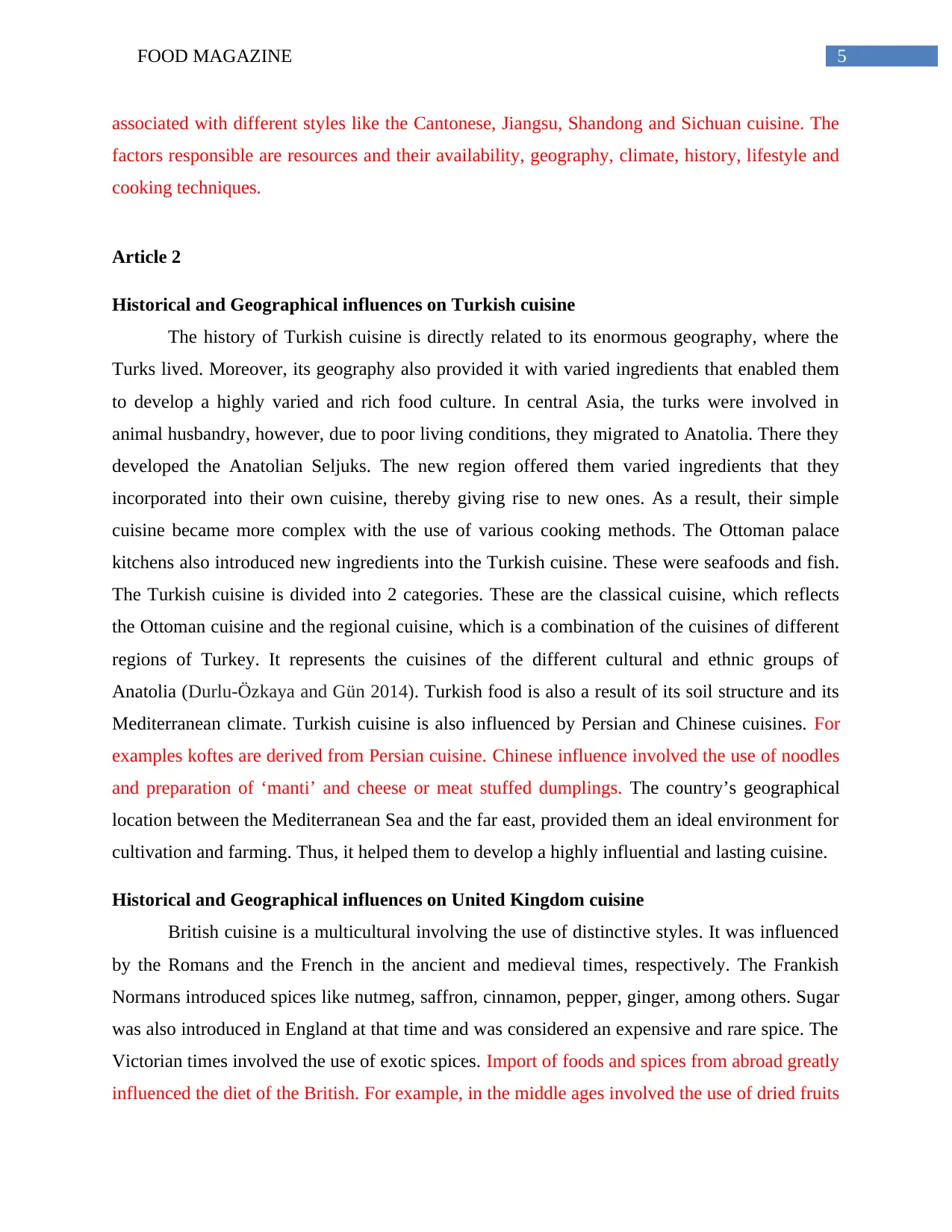
5FOOD MAGAZINE
associated with different styles like the Cantonese, Jiangsu, Shandong and Sichuan cuisine. The
factors responsible are resources and their availability, geography, climate, history, lifestyle and
cooking techniques.
Article 2
Historical and Geographical influences on Turkish cuisine
The history of Turkish cuisine is directly related to its enormous geography, where the
Turks lived. Moreover, its geography also provided it with varied ingredients that enabled them
to develop a highly varied and rich food culture. In central Asia, the turks were involved in
animal husbandry, however, due to poor living conditions, they migrated to Anatolia. There they
developed the Anatolian Seljuks. The new region offered them varied ingredients that they
incorporated into their own cuisine, thereby giving rise to new ones. As a result, their simple
cuisine became more complex with the use of various cooking methods. The Ottoman palace
kitchens also introduced new ingredients into the Turkish cuisine. These were seafoods and fish.
The Turkish cuisine is divided into 2 categories. These are the classical cuisine, which reflects
the Ottoman cuisine and the regional cuisine, which is a combination of the cuisines of different
regions of Turkey. It represents the cuisines of the different cultural and ethnic groups of
Anatolia (Durlu-Özkaya and Gün 2014). Turkish food is also a result of its soil structure and its
Mediterranean climate. Turkish cuisine is also influenced by Persian and Chinese cuisines. For
examples koftes are derived from Persian cuisine. Chinese influence involved the use of noodles
and preparation of ‘manti’ and cheese or meat stuffed dumplings. The country’s geographical
location between the Mediterranean Sea and the far east, provided them an ideal environment for
cultivation and farming. Thus, it helped them to develop a highly influential and lasting cuisine.
Historical and Geographical influences on United Kingdom cuisine
British cuisine is a multicultural involving the use of distinctive styles. It was influenced
by the Romans and the French in the ancient and medieval times, respectively. The Frankish
Normans introduced spices like nutmeg, saffron, cinnamon, pepper, ginger, among others. Sugar
was also introduced in England at that time and was considered an expensive and rare spice. The
Victorian times involved the use of exotic spices. Import of foods and spices from abroad greatly
influenced the diet of the British. For example, in the middle ages involved the use of dried fruits
associated with different styles like the Cantonese, Jiangsu, Shandong and Sichuan cuisine. The
factors responsible are resources and their availability, geography, climate, history, lifestyle and
cooking techniques.
Article 2
Historical and Geographical influences on Turkish cuisine
The history of Turkish cuisine is directly related to its enormous geography, where the
Turks lived. Moreover, its geography also provided it with varied ingredients that enabled them
to develop a highly varied and rich food culture. In central Asia, the turks were involved in
animal husbandry, however, due to poor living conditions, they migrated to Anatolia. There they
developed the Anatolian Seljuks. The new region offered them varied ingredients that they
incorporated into their own cuisine, thereby giving rise to new ones. As a result, their simple
cuisine became more complex with the use of various cooking methods. The Ottoman palace
kitchens also introduced new ingredients into the Turkish cuisine. These were seafoods and fish.
The Turkish cuisine is divided into 2 categories. These are the classical cuisine, which reflects
the Ottoman cuisine and the regional cuisine, which is a combination of the cuisines of different
regions of Turkey. It represents the cuisines of the different cultural and ethnic groups of
Anatolia (Durlu-Özkaya and Gün 2014). Turkish food is also a result of its soil structure and its
Mediterranean climate. Turkish cuisine is also influenced by Persian and Chinese cuisines. For
examples koftes are derived from Persian cuisine. Chinese influence involved the use of noodles
and preparation of ‘manti’ and cheese or meat stuffed dumplings. The country’s geographical
location between the Mediterranean Sea and the far east, provided them an ideal environment for
cultivation and farming. Thus, it helped them to develop a highly influential and lasting cuisine.
Historical and Geographical influences on United Kingdom cuisine
British cuisine is a multicultural involving the use of distinctive styles. It was influenced
by the Romans and the French in the ancient and medieval times, respectively. The Frankish
Normans introduced spices like nutmeg, saffron, cinnamon, pepper, ginger, among others. Sugar
was also introduced in England at that time and was considered an expensive and rare spice. The
Victorian times involved the use of exotic spices. Import of foods and spices from abroad greatly
influenced the diet of the British. For example, in the middle ages involved the use of dried fruits
⊘ This is a preview!⊘
Do you want full access?
Subscribe today to unlock all pages.

Trusted by 1+ million students worldwide
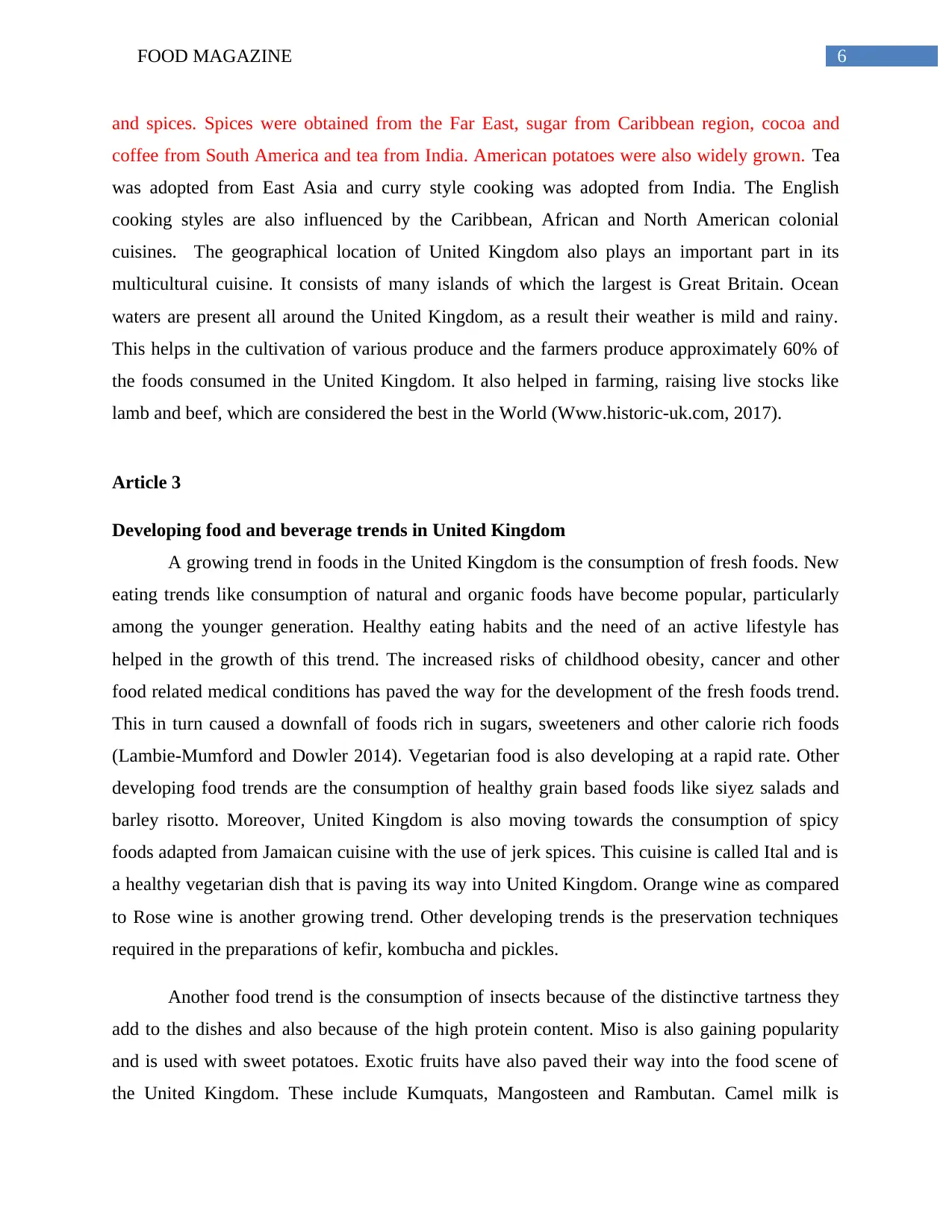
6FOOD MAGAZINE
and spices. Spices were obtained from the Far East, sugar from Caribbean region, cocoa and
coffee from South America and tea from India. American potatoes were also widely grown. Tea
was adopted from East Asia and curry style cooking was adopted from India. The English
cooking styles are also influenced by the Caribbean, African and North American colonial
cuisines. The geographical location of United Kingdom also plays an important part in its
multicultural cuisine. It consists of many islands of which the largest is Great Britain. Ocean
waters are present all around the United Kingdom, as a result their weather is mild and rainy.
This helps in the cultivation of various produce and the farmers produce approximately 60% of
the foods consumed in the United Kingdom. It also helped in farming, raising live stocks like
lamb and beef, which are considered the best in the World (Www.historic-uk.com, 2017).
Article 3
Developing food and beverage trends in United Kingdom
A growing trend in foods in the United Kingdom is the consumption of fresh foods. New
eating trends like consumption of natural and organic foods have become popular, particularly
among the younger generation. Healthy eating habits and the need of an active lifestyle has
helped in the growth of this trend. The increased risks of childhood obesity, cancer and other
food related medical conditions has paved the way for the development of the fresh foods trend.
This in turn caused a downfall of foods rich in sugars, sweeteners and other calorie rich foods
(Lambie-Mumford and Dowler 2014). Vegetarian food is also developing at a rapid rate. Other
developing food trends are the consumption of healthy grain based foods like siyez salads and
barley risotto. Moreover, United Kingdom is also moving towards the consumption of spicy
foods adapted from Jamaican cuisine with the use of jerk spices. This cuisine is called Ital and is
a healthy vegetarian dish that is paving its way into United Kingdom. Orange wine as compared
to Rose wine is another growing trend. Other developing trends is the preservation techniques
required in the preparations of kefir, kombucha and pickles.
Another food trend is the consumption of insects because of the distinctive tartness they
add to the dishes and also because of the high protein content. Miso is also gaining popularity
and is used with sweet potatoes. Exotic fruits have also paved their way into the food scene of
the United Kingdom. These include Kumquats, Mangosteen and Rambutan. Camel milk is
and spices. Spices were obtained from the Far East, sugar from Caribbean region, cocoa and
coffee from South America and tea from India. American potatoes were also widely grown. Tea
was adopted from East Asia and curry style cooking was adopted from India. The English
cooking styles are also influenced by the Caribbean, African and North American colonial
cuisines. The geographical location of United Kingdom also plays an important part in its
multicultural cuisine. It consists of many islands of which the largest is Great Britain. Ocean
waters are present all around the United Kingdom, as a result their weather is mild and rainy.
This helps in the cultivation of various produce and the farmers produce approximately 60% of
the foods consumed in the United Kingdom. It also helped in farming, raising live stocks like
lamb and beef, which are considered the best in the World (Www.historic-uk.com, 2017).
Article 3
Developing food and beverage trends in United Kingdom
A growing trend in foods in the United Kingdom is the consumption of fresh foods. New
eating trends like consumption of natural and organic foods have become popular, particularly
among the younger generation. Healthy eating habits and the need of an active lifestyle has
helped in the growth of this trend. The increased risks of childhood obesity, cancer and other
food related medical conditions has paved the way for the development of the fresh foods trend.
This in turn caused a downfall of foods rich in sugars, sweeteners and other calorie rich foods
(Lambie-Mumford and Dowler 2014). Vegetarian food is also developing at a rapid rate. Other
developing food trends are the consumption of healthy grain based foods like siyez salads and
barley risotto. Moreover, United Kingdom is also moving towards the consumption of spicy
foods adapted from Jamaican cuisine with the use of jerk spices. This cuisine is called Ital and is
a healthy vegetarian dish that is paving its way into United Kingdom. Orange wine as compared
to Rose wine is another growing trend. Other developing trends is the preservation techniques
required in the preparations of kefir, kombucha and pickles.
Another food trend is the consumption of insects because of the distinctive tartness they
add to the dishes and also because of the high protein content. Miso is also gaining popularity
and is used with sweet potatoes. Exotic fruits have also paved their way into the food scene of
the United Kingdom. These include Kumquats, Mangosteen and Rambutan. Camel milk is
Paraphrase This Document
Need a fresh take? Get an instant paraphrase of this document with our AI Paraphraser
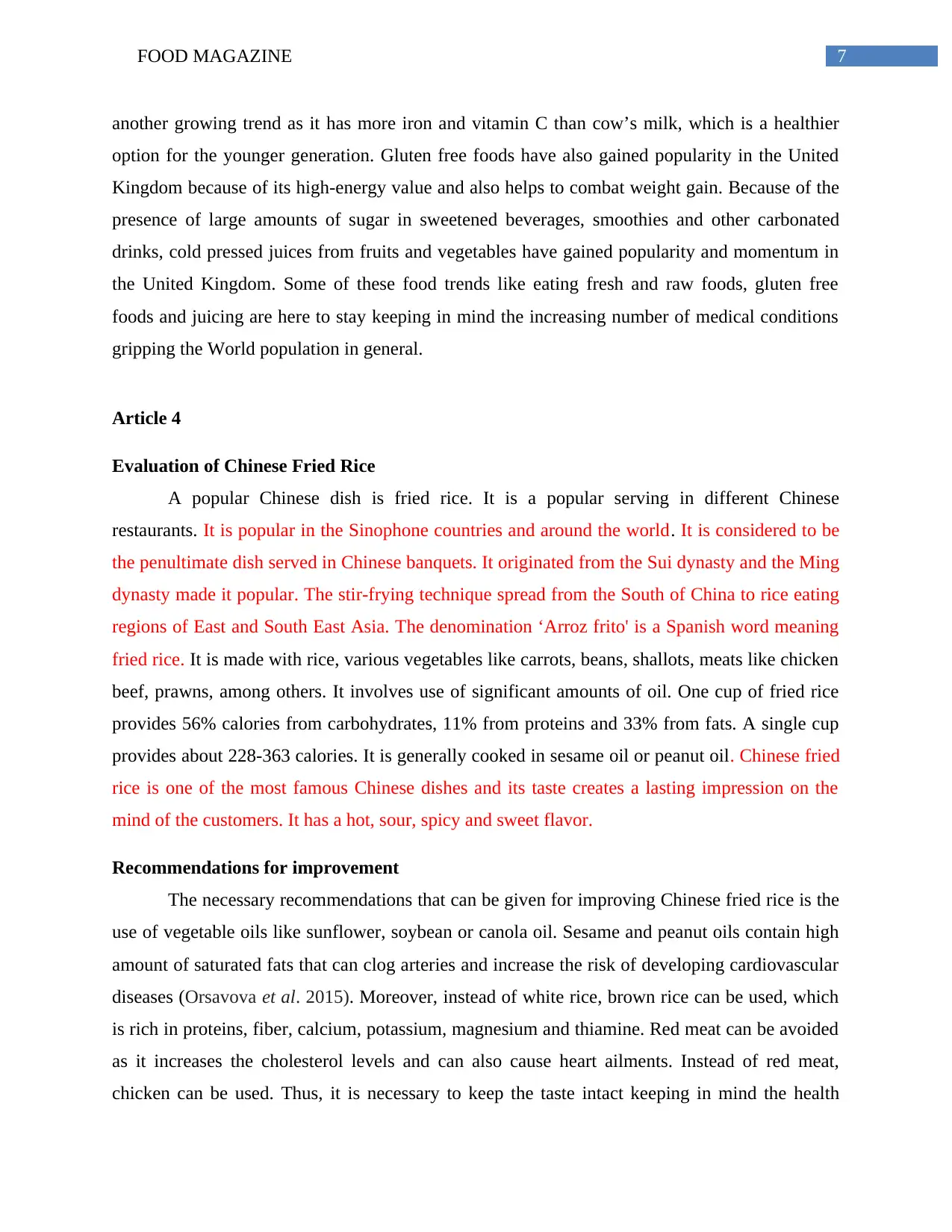
7FOOD MAGAZINE
another growing trend as it has more iron and vitamin C than cow’s milk, which is a healthier
option for the younger generation. Gluten free foods have also gained popularity in the United
Kingdom because of its high-energy value and also helps to combat weight gain. Because of the
presence of large amounts of sugar in sweetened beverages, smoothies and other carbonated
drinks, cold pressed juices from fruits and vegetables have gained popularity and momentum in
the United Kingdom. Some of these food trends like eating fresh and raw foods, gluten free
foods and juicing are here to stay keeping in mind the increasing number of medical conditions
gripping the World population in general.
Article 4
Evaluation of Chinese Fried Rice
A popular Chinese dish is fried rice. It is a popular serving in different Chinese
restaurants. It is popular in the Sinophone countries and around the world. It is considered to be
the penultimate dish served in Chinese banquets. It originated from the Sui dynasty and the Ming
dynasty made it popular. The stir-frying technique spread from the South of China to rice eating
regions of East and South East Asia. The denomination ‘Arroz frito' is a Spanish word meaning
fried rice. It is made with rice, various vegetables like carrots, beans, shallots, meats like chicken
beef, prawns, among others. It involves use of significant amounts of oil. One cup of fried rice
provides 56% calories from carbohydrates, 11% from proteins and 33% from fats. A single cup
provides about 228-363 calories. It is generally cooked in sesame oil or peanut oil. Chinese fried
rice is one of the most famous Chinese dishes and its taste creates a lasting impression on the
mind of the customers. It has a hot, sour, spicy and sweet flavor.
Recommendations for improvement
The necessary recommendations that can be given for improving Chinese fried rice is the
use of vegetable oils like sunflower, soybean or canola oil. Sesame and peanut oils contain high
amount of saturated fats that can clog arteries and increase the risk of developing cardiovascular
diseases (Orsavova et al. 2015). Moreover, instead of white rice, brown rice can be used, which
is rich in proteins, fiber, calcium, potassium, magnesium and thiamine. Red meat can be avoided
as it increases the cholesterol levels and can also cause heart ailments. Instead of red meat,
chicken can be used. Thus, it is necessary to keep the taste intact keeping in mind the health
another growing trend as it has more iron and vitamin C than cow’s milk, which is a healthier
option for the younger generation. Gluten free foods have also gained popularity in the United
Kingdom because of its high-energy value and also helps to combat weight gain. Because of the
presence of large amounts of sugar in sweetened beverages, smoothies and other carbonated
drinks, cold pressed juices from fruits and vegetables have gained popularity and momentum in
the United Kingdom. Some of these food trends like eating fresh and raw foods, gluten free
foods and juicing are here to stay keeping in mind the increasing number of medical conditions
gripping the World population in general.
Article 4
Evaluation of Chinese Fried Rice
A popular Chinese dish is fried rice. It is a popular serving in different Chinese
restaurants. It is popular in the Sinophone countries and around the world. It is considered to be
the penultimate dish served in Chinese banquets. It originated from the Sui dynasty and the Ming
dynasty made it popular. The stir-frying technique spread from the South of China to rice eating
regions of East and South East Asia. The denomination ‘Arroz frito' is a Spanish word meaning
fried rice. It is made with rice, various vegetables like carrots, beans, shallots, meats like chicken
beef, prawns, among others. It involves use of significant amounts of oil. One cup of fried rice
provides 56% calories from carbohydrates, 11% from proteins and 33% from fats. A single cup
provides about 228-363 calories. It is generally cooked in sesame oil or peanut oil. Chinese fried
rice is one of the most famous Chinese dishes and its taste creates a lasting impression on the
mind of the customers. It has a hot, sour, spicy and sweet flavor.
Recommendations for improvement
The necessary recommendations that can be given for improving Chinese fried rice is the
use of vegetable oils like sunflower, soybean or canola oil. Sesame and peanut oils contain high
amount of saturated fats that can clog arteries and increase the risk of developing cardiovascular
diseases (Orsavova et al. 2015). Moreover, instead of white rice, brown rice can be used, which
is rich in proteins, fiber, calcium, potassium, magnesium and thiamine. Red meat can be avoided
as it increases the cholesterol levels and can also cause heart ailments. Instead of red meat,
chicken can be used. Thus, it is necessary to keep the taste intact keeping in mind the health
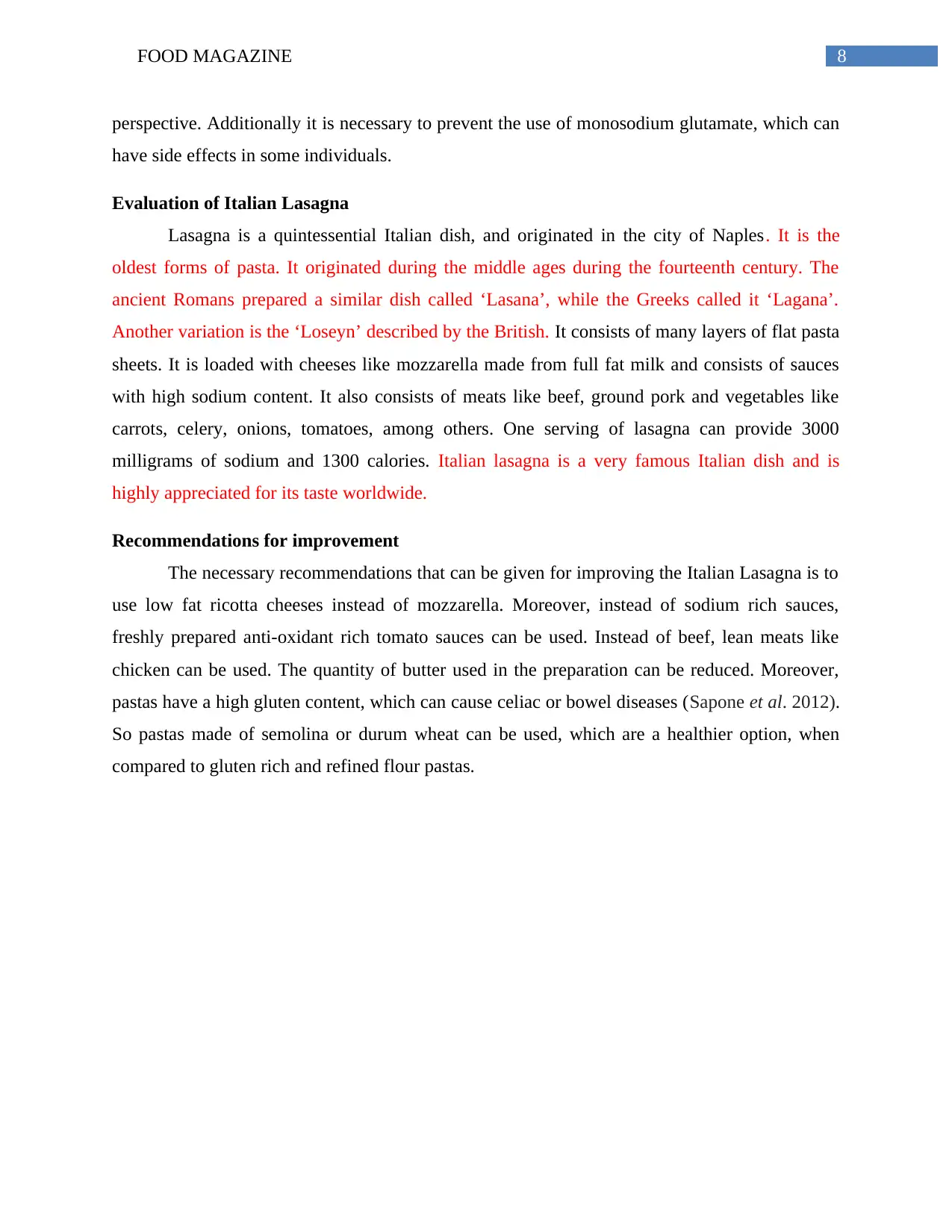
8FOOD MAGAZINE
perspective. Additionally it is necessary to prevent the use of monosodium glutamate, which can
have side effects in some individuals.
Evaluation of Italian Lasagna
Lasagna is a quintessential Italian dish, and originated in the city of Naples. It is the
oldest forms of pasta. It originated during the middle ages during the fourteenth century. The
ancient Romans prepared a similar dish called ‘Lasana’, while the Greeks called it ‘Lagana’.
Another variation is the ‘Loseyn’ described by the British. It consists of many layers of flat pasta
sheets. It is loaded with cheeses like mozzarella made from full fat milk and consists of sauces
with high sodium content. It also consists of meats like beef, ground pork and vegetables like
carrots, celery, onions, tomatoes, among others. One serving of lasagna can provide 3000
milligrams of sodium and 1300 calories. Italian lasagna is a very famous Italian dish and is
highly appreciated for its taste worldwide.
Recommendations for improvement
The necessary recommendations that can be given for improving the Italian Lasagna is to
use low fat ricotta cheeses instead of mozzarella. Moreover, instead of sodium rich sauces,
freshly prepared anti-oxidant rich tomato sauces can be used. Instead of beef, lean meats like
chicken can be used. The quantity of butter used in the preparation can be reduced. Moreover,
pastas have a high gluten content, which can cause celiac or bowel diseases (Sapone et al. 2012).
So pastas made of semolina or durum wheat can be used, which are a healthier option, when
compared to gluten rich and refined flour pastas.
perspective. Additionally it is necessary to prevent the use of monosodium glutamate, which can
have side effects in some individuals.
Evaluation of Italian Lasagna
Lasagna is a quintessential Italian dish, and originated in the city of Naples. It is the
oldest forms of pasta. It originated during the middle ages during the fourteenth century. The
ancient Romans prepared a similar dish called ‘Lasana’, while the Greeks called it ‘Lagana’.
Another variation is the ‘Loseyn’ described by the British. It consists of many layers of flat pasta
sheets. It is loaded with cheeses like mozzarella made from full fat milk and consists of sauces
with high sodium content. It also consists of meats like beef, ground pork and vegetables like
carrots, celery, onions, tomatoes, among others. One serving of lasagna can provide 3000
milligrams of sodium and 1300 calories. Italian lasagna is a very famous Italian dish and is
highly appreciated for its taste worldwide.
Recommendations for improvement
The necessary recommendations that can be given for improving the Italian Lasagna is to
use low fat ricotta cheeses instead of mozzarella. Moreover, instead of sodium rich sauces,
freshly prepared anti-oxidant rich tomato sauces can be used. Instead of beef, lean meats like
chicken can be used. The quantity of butter used in the preparation can be reduced. Moreover,
pastas have a high gluten content, which can cause celiac or bowel diseases (Sapone et al. 2012).
So pastas made of semolina or durum wheat can be used, which are a healthier option, when
compared to gluten rich and refined flour pastas.
⊘ This is a preview!⊘
Do you want full access?
Subscribe today to unlock all pages.

Trusted by 1+ million students worldwide
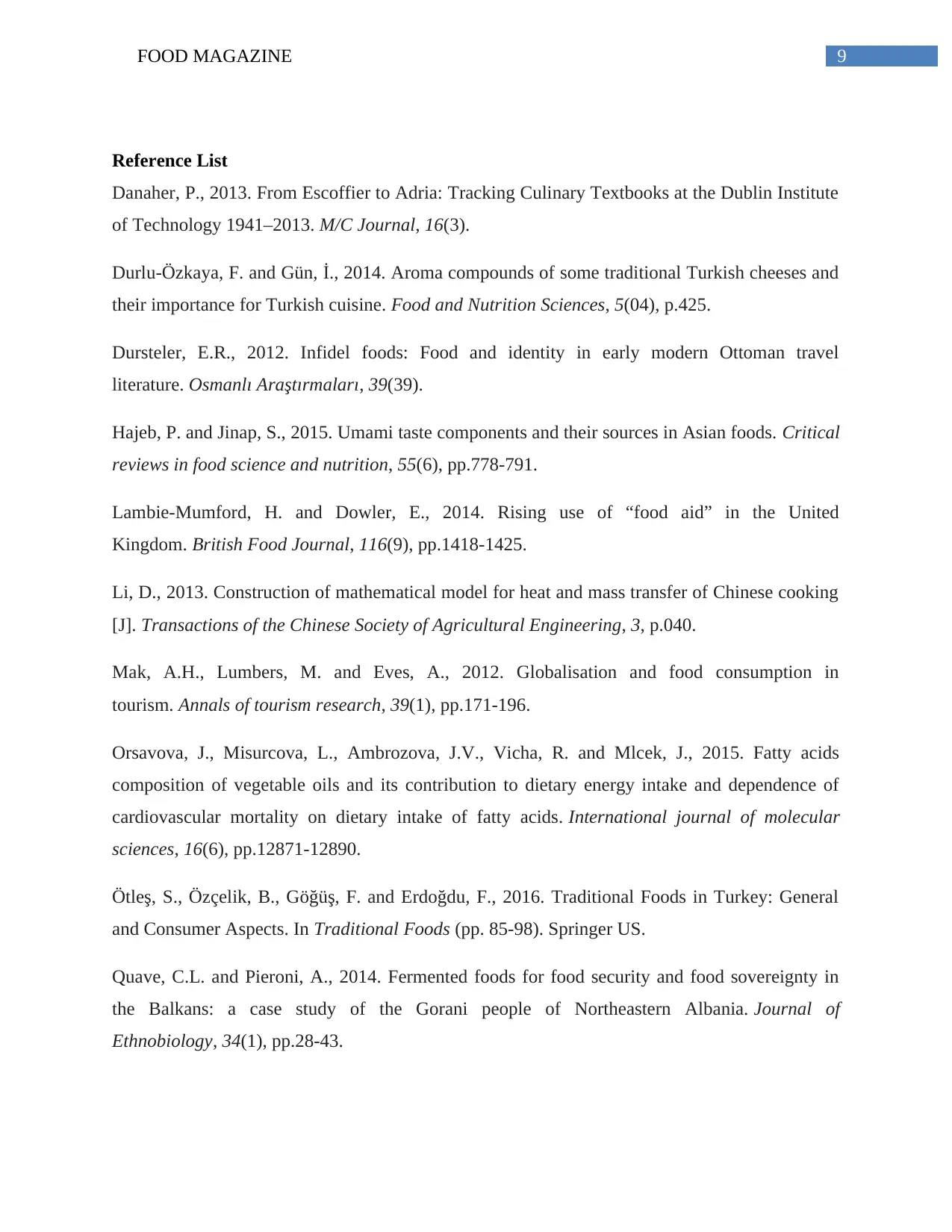
9FOOD MAGAZINE
Reference List
Danaher, P., 2013. From Escoffier to Adria: Tracking Culinary Textbooks at the Dublin Institute
of Technology 1941–2013. M/C Journal, 16(3).
Durlu-Özkaya, F. and Gün, İ., 2014. Aroma compounds of some traditional Turkish cheeses and
their importance for Turkish cuisine. Food and Nutrition Sciences, 5(04), p.425.
Dursteler, E.R., 2012. Infidel foods: Food and identity in early modern Ottoman travel
literature. Osmanlı Araştırmaları, 39(39).
Hajeb, P. and Jinap, S., 2015. Umami taste components and their sources in Asian foods. Critical
reviews in food science and nutrition, 55(6), pp.778-791.
Lambie-Mumford, H. and Dowler, E., 2014. Rising use of “food aid” in the United
Kingdom. British Food Journal, 116(9), pp.1418-1425.
Li, D., 2013. Construction of mathematical model for heat and mass transfer of Chinese cooking
[J]. Transactions of the Chinese Society of Agricultural Engineering, 3, p.040.
Mak, A.H., Lumbers, M. and Eves, A., 2012. Globalisation and food consumption in
tourism. Annals of tourism research, 39(1), pp.171-196.
Orsavova, J., Misurcova, L., Ambrozova, J.V., Vicha, R. and Mlcek, J., 2015. Fatty acids
composition of vegetable oils and its contribution to dietary energy intake and dependence of
cardiovascular mortality on dietary intake of fatty acids. International journal of molecular
sciences, 16(6), pp.12871-12890.
Ötleş, S., Özçelik, B., Göğüş, F. and Erdoğdu, F., 2016. Traditional Foods in Turkey: General
and Consumer Aspects. In Traditional Foods (pp. 85-98). Springer US.
Quave, C.L. and Pieroni, A., 2014. Fermented foods for food security and food sovereignty in
the Balkans: a case study of the Gorani people of Northeastern Albania. Journal of
Ethnobiology, 34(1), pp.28-43.
Reference List
Danaher, P., 2013. From Escoffier to Adria: Tracking Culinary Textbooks at the Dublin Institute
of Technology 1941–2013. M/C Journal, 16(3).
Durlu-Özkaya, F. and Gün, İ., 2014. Aroma compounds of some traditional Turkish cheeses and
their importance for Turkish cuisine. Food and Nutrition Sciences, 5(04), p.425.
Dursteler, E.R., 2012. Infidel foods: Food and identity in early modern Ottoman travel
literature. Osmanlı Araştırmaları, 39(39).
Hajeb, P. and Jinap, S., 2015. Umami taste components and their sources in Asian foods. Critical
reviews in food science and nutrition, 55(6), pp.778-791.
Lambie-Mumford, H. and Dowler, E., 2014. Rising use of “food aid” in the United
Kingdom. British Food Journal, 116(9), pp.1418-1425.
Li, D., 2013. Construction of mathematical model for heat and mass transfer of Chinese cooking
[J]. Transactions of the Chinese Society of Agricultural Engineering, 3, p.040.
Mak, A.H., Lumbers, M. and Eves, A., 2012. Globalisation and food consumption in
tourism. Annals of tourism research, 39(1), pp.171-196.
Orsavova, J., Misurcova, L., Ambrozova, J.V., Vicha, R. and Mlcek, J., 2015. Fatty acids
composition of vegetable oils and its contribution to dietary energy intake and dependence of
cardiovascular mortality on dietary intake of fatty acids. International journal of molecular
sciences, 16(6), pp.12871-12890.
Ötleş, S., Özçelik, B., Göğüş, F. and Erdoğdu, F., 2016. Traditional Foods in Turkey: General
and Consumer Aspects. In Traditional Foods (pp. 85-98). Springer US.
Quave, C.L. and Pieroni, A., 2014. Fermented foods for food security and food sovereignty in
the Balkans: a case study of the Gorani people of Northeastern Albania. Journal of
Ethnobiology, 34(1), pp.28-43.
Paraphrase This Document
Need a fresh take? Get an instant paraphrase of this document with our AI Paraphraser
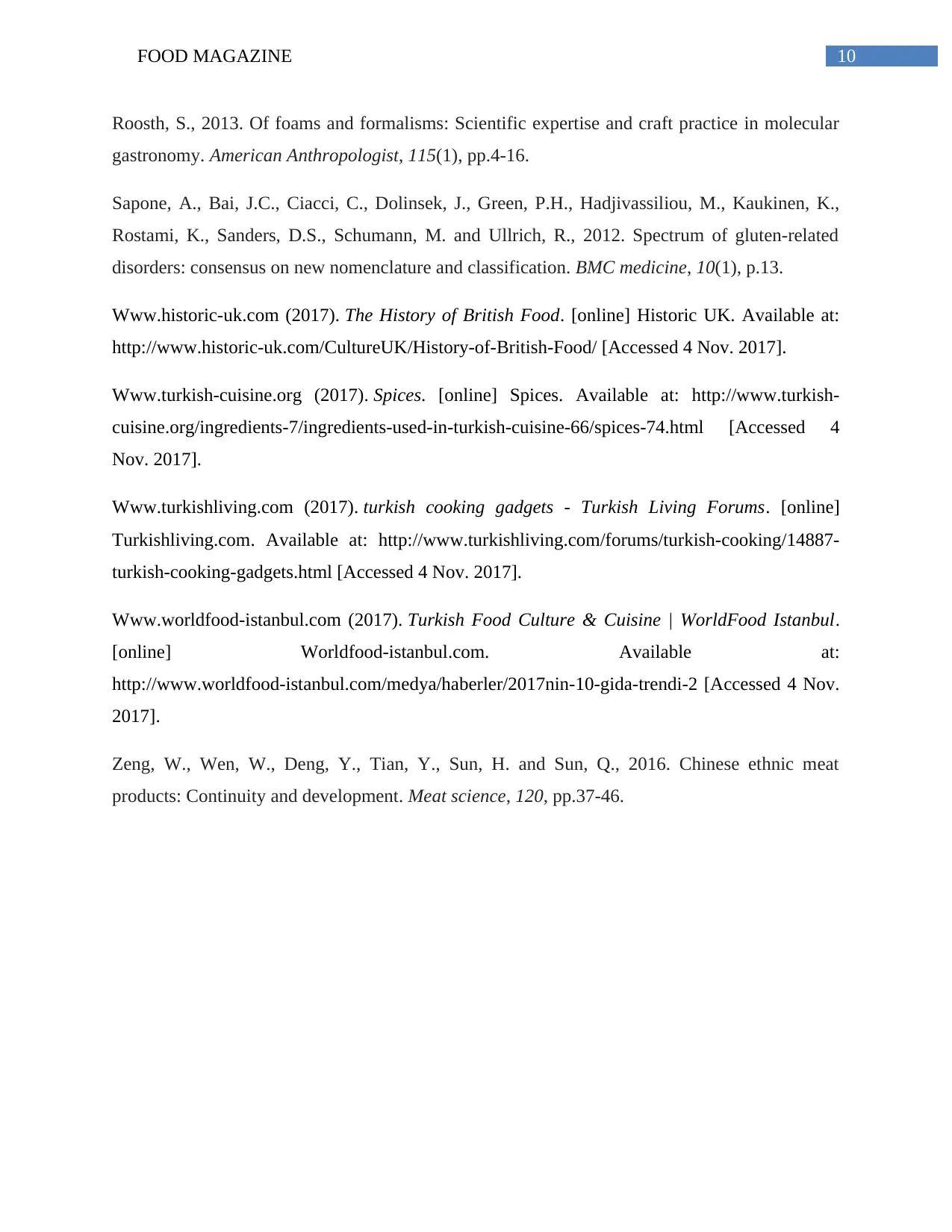
10FOOD MAGAZINE
Roosth, S., 2013. Of foams and formalisms: Scientific expertise and craft practice in molecular
gastronomy. American Anthropologist, 115(1), pp.4-16.
Sapone, A., Bai, J.C., Ciacci, C., Dolinsek, J., Green, P.H., Hadjivassiliou, M., Kaukinen, K.,
Rostami, K., Sanders, D.S., Schumann, M. and Ullrich, R., 2012. Spectrum of gluten-related
disorders: consensus on new nomenclature and classification. BMC medicine, 10(1), p.13.
Www.historic-uk.com (2017). The History of British Food. [online] Historic UK. Available at:
http://www.historic-uk.com/CultureUK/History-of-British-Food/ [Accessed 4 Nov. 2017].
Www.turkish-cuisine.org (2017). Spices. [online] Spices. Available at: http://www.turkish-
cuisine.org/ingredients-7/ingredients-used-in-turkish-cuisine-66/spices-74.html [Accessed 4
Nov. 2017].
Www.turkishliving.com (2017). turkish cooking gadgets - Turkish Living Forums. [online]
Turkishliving.com. Available at: http://www.turkishliving.com/forums/turkish-cooking/14887-
turkish-cooking-gadgets.html [Accessed 4 Nov. 2017].
Www.worldfood-istanbul.com (2017). Turkish Food Culture & Cuisine | WorldFood Istanbul.
[online] Worldfood-istanbul.com. Available at:
http://www.worldfood-istanbul.com/medya/haberler/2017nin-10-gida-trendi-2 [Accessed 4 Nov.
2017].
Zeng, W., Wen, W., Deng, Y., Tian, Y., Sun, H. and Sun, Q., 2016. Chinese ethnic meat
products: Continuity and development. Meat science, 120, pp.37-46.
Roosth, S., 2013. Of foams and formalisms: Scientific expertise and craft practice in molecular
gastronomy. American Anthropologist, 115(1), pp.4-16.
Sapone, A., Bai, J.C., Ciacci, C., Dolinsek, J., Green, P.H., Hadjivassiliou, M., Kaukinen, K.,
Rostami, K., Sanders, D.S., Schumann, M. and Ullrich, R., 2012. Spectrum of gluten-related
disorders: consensus on new nomenclature and classification. BMC medicine, 10(1), p.13.
Www.historic-uk.com (2017). The History of British Food. [online] Historic UK. Available at:
http://www.historic-uk.com/CultureUK/History-of-British-Food/ [Accessed 4 Nov. 2017].
Www.turkish-cuisine.org (2017). Spices. [online] Spices. Available at: http://www.turkish-
cuisine.org/ingredients-7/ingredients-used-in-turkish-cuisine-66/spices-74.html [Accessed 4
Nov. 2017].
Www.turkishliving.com (2017). turkish cooking gadgets - Turkish Living Forums. [online]
Turkishliving.com. Available at: http://www.turkishliving.com/forums/turkish-cooking/14887-
turkish-cooking-gadgets.html [Accessed 4 Nov. 2017].
Www.worldfood-istanbul.com (2017). Turkish Food Culture & Cuisine | WorldFood Istanbul.
[online] Worldfood-istanbul.com. Available at:
http://www.worldfood-istanbul.com/medya/haberler/2017nin-10-gida-trendi-2 [Accessed 4 Nov.
2017].
Zeng, W., Wen, W., Deng, Y., Tian, Y., Sun, H. and Sun, Q., 2016. Chinese ethnic meat
products: Continuity and development. Meat science, 120, pp.37-46.
1 out of 11
Related Documents
Your All-in-One AI-Powered Toolkit for Academic Success.
+13062052269
info@desklib.com
Available 24*7 on WhatsApp / Email
![[object Object]](/_next/static/media/star-bottom.7253800d.svg)
Unlock your academic potential
Copyright © 2020–2025 A2Z Services. All Rights Reserved. Developed and managed by ZUCOL.





